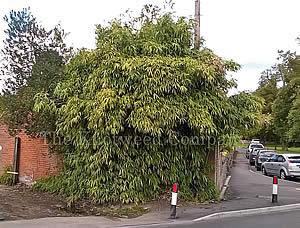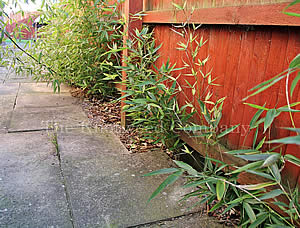Bamboo – General Information

In the 1990s, almost every gardening expert on TV was extolling the virtues of planting a ‘bamboo screen’ in residential gardens, proving that the lessons of the past of introducing and promoting species such as Japanese knotweed have not been learned. Bamboo shares certain characteristics with knotweed, and the lack of advice provided by those TV experts during their recommendations – in regard to bamboo maintenance and its suitability for particular locations – has led to an increasing number of neighbour disputes and related issues.
There are over a thousand different species of bamboo, though their growing characteristics can typically divide them into two types: so-called ‘clumpers’ and ‘runners’. Both types spread by way of rhizomes but in different ways. The ‘clumpers’ produce rhizomes that immediately rise to the surface to emerge as new shoots in close proximity to the existing growth. This means their base is dense and ‘clumpy’, hence the name. As such they spread fairly slowly. The ‘runners’ send rhizomes a distance away from the plant before producing new upright shoots from them, with shoots capable of emerging anywhere along the rhizome length. Running rhizomes grow under fences, walls, etc. in precisely the same way as knotweed does – only the woody rhizomes are much stronger and may have a greater capacity to cause damage to the built environment than their knotweed counterparts. Many bamboo species see new shoots emerging fully formed and these shoots have been known to grow through cracks in walls, gaps in paving, etc. and to push these man-made structures aside as they grow, causing damage or dangerous trip hazards. Rhizome penetration of house foundations has also been recorded, though more research is required to determine if this is a widespread phenomenon or only occurs in exceptional cases where the conditions are favourable for such an event.

Whilst the British climate makes it unlikely that bamboo here will reach its maximum height and spread, rhizomes in mature ‘runner’ plants are known to spread 1 to 1.5m on average in a year, with up to 4.5m spread in one season having been recorded by some species. Bamboo can grow by 1m in height each year until it reaches its optimum height. The taller it grows, the further the rhizome structure will spread to feed the growth. During the winter, bamboo expands its root mass to support the new shoots that will emerge in the spring. The thin and fibrous roots can grow as deep as 1m but the rhizomes tend to remain shallow (usually within the top third of a metre) and are often visible on the surface. That said, certain circumstances can lead to rhizomes burrowing deeper - sometimes up to a metre in depth.
With the widespread planting of ‘runner’ species of bamboo along boundaries (as a bamboo screen), many people have found their gardens blighted by unwanted bamboo groves growing from rhizomes spreading from adjacent properties. Bamboo can regenerate from fragments of rhizome and this can lead to the spread of bamboo around a property as the result of attempts to control or remove it. Even where rhizome spread is less of an issue (with a ‘clumper’ species, for example), bamboo can grow several metres in height and can cause shading issues along boundaries. So-called ‘high hedge’ legislation is little help in this circumstance, since bamboo does not qualify for inclusion under this legislation. It is easy to see therefore why an increasing number of people are considering legal action against their neighbours regarding their bamboo.
Bamboo outbreaks, along with Pampas grass, are becoming increasingly common. In many instances, it is the direct result of spread across property boundaries, but these plants are also being found in the wild. It is possible these outbreaks in wild areas are the result of incorrect disposal of bamboo material, though other causes may also be involved. These outbreaks may be relatively small or may cover hundreds or even thousands of square metres.

Ridding yourself of bamboo is not always straightforward. Pulling or hand-digging rhizomes can be highly labour-intensive and always runs the risk of rhizomes snapping and remaining in the soil (where they will regrow). Bamboo can be controlled using the correct herbicides, but a programme of treatments will take several seasons to complete. Containment of bamboo is vital, though running bamboo species can often be found growing over the tops of containers or bamboo-resistant root barriers, so constant vigilance is required. As a result, it is our view that bamboo is not suitable for the average domestic garden and would fully support any measures to limit or prevent the planting of bamboo in residential areas. In any case, bamboo should not be planted near boundaries, hard surfaces or buildings unless very diligently contained.
Please contact us for further advice if you are facing a bamboo problem. The Knotweed Company are well-versed in dealing with bamboo and can supply a range of options.
Please read our cookies and privacy policy here
Copyright © 2018 · All Rights Reserved ·